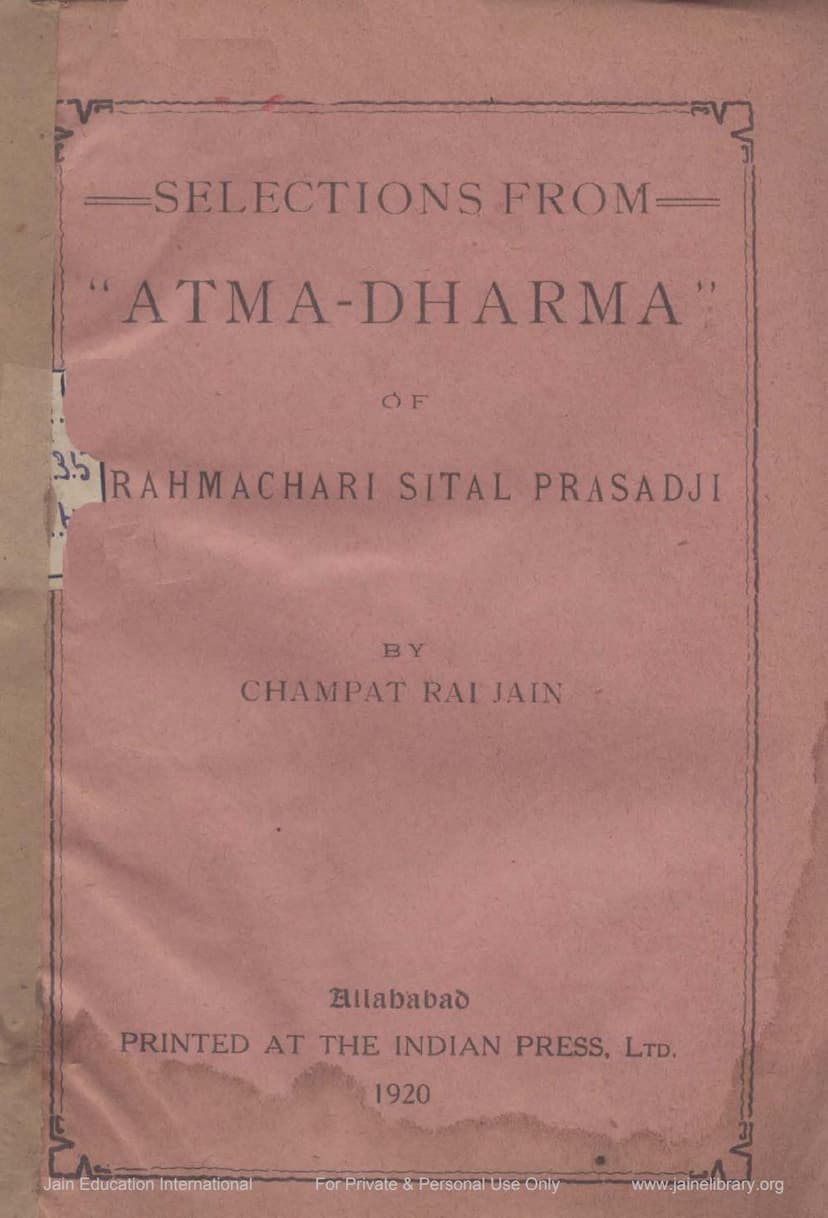Atma Dharma
Added to library: September 1, 2025

Summary
Here's a comprehensive summary of "Atma Dharma" by Champat Rai Jain, based on the provided text:
Book Title: Atma-Dharma (Selections and Musings) Author: Champat Rai Jain (Selections and Musings from the work of Brahmachari Sital Prasadji) Publisher: Champat Rai Jain Publication Year: 1920
Core Theme: "Atma Dharma" (The Dharma of the Soul) is a philosophical exploration of the Jain perspective on the true nature of the soul, its inherent happiness, the causes of suffering, and the path to liberation. The book emphasizes introspection, self-realization, and the cultivation of virtues as the means to achieve ultimate peace and bliss.
Key Concepts and Arguments:
-
Universal Desire for Happiness:
- The text begins by establishing a fundamental truth: all living beings, from humans to the smallest insects and even plants, instinctively abhor pain and misery and desire happiness and peace.
- This desire is universal, cutting across species, social status, origin, or faith.
-
The Nature of Happiness:
- True Happiness is Innate to the Soul: The book argues that true happiness is not derived from external objects, circumstances, or sensory pleasures. These external sources provide only imaginary or dependent happiness (parâdhîn), which is fleeting and ultimately unsatisfying.
- Passions as Obstacles: Passions like anger, pride, greed, jealousy, and worry are identified as the primary culprits that rob the soul of its natural peace and joy. These are not inherent qualities of the soul but rather external influences that cause mental agitation and suffering.
- Happiness as an Attribute of the Soul: True, enduring happiness is an inherent attribute or property of the soul (Atma). When passions are quiescent, this natural bliss is experienced directly.
-
The Nature of the Soul (Atma):
- Consciousness as the Distinguishing Feature: The defining characteristic of the soul is consciousness (Chaitanya), the capacity to perceive, know, think, feel, and will. This is its unique identifier, distinguishing it from non-living matter (Pudgala) and other substances.
- Beyond Physical and Mental: The soul is distinct from the physical body, senses, mind, emotions, thoughts, and even the subtle karmic body. These are all considered vibhâvik (extraneous) modifications, arising from the soul's association with matter.
- Inherent Perfections: In its pure state, the soul is endowed with infinite knowledge, bliss, energy, and purity. It is immortal, eternal, and inherently perfect.
- Individuality: Each soul is an individual, self-contained entity, independent of all others. The idea of a single, universal soul is rejected.
- Expansion and Contraction: The soul has the unique ability to expand or contract, filling the body it inhabits, and even potentially extending beyond physical confines (as in samudghâta).
-
The Causes of Suffering (Dukkha):
- Association with Matter and Karmas: Suffering arises from the soul's entanglement with matter and the karmic forces generated by actions, desires, and attachments.
- Ignorance and Infatuation: Ignorance (Avidya) and infatuation (Moha) obscure the soul's true nature, leading to false beliefs and actions that perpetuate the cycle of suffering.
- External Dependence: Relying on external objects for happiness creates a state of dependence, making one vulnerable to loss, change, and disappointment.
-
The Path to Self-Realization and Liberation (Moksha):
- Introspection and Self-Knowledge: The central path is to turn inwards and seek knowledge of one's own true self (Atma-jnana). This is not merely intellectual understanding but a direct, experiential realization.
- Meditation (Dhyana): Meditation is presented as a crucial practice for quieting the mind, focusing attention inward, and experiencing the soul directly.
- Preparation for Meditation: This includes maintaining physical and mental equilibrium, cultivating dispassion (Vairagya), controlling the senses, abstaining from harmful actions (especially violence), and adopting a disciplined lifestyle (pure food, controlled speech).
- Methods of Meditation: Various visualization techniques and meditative aids are described, often drawing from Jain scriptural traditions, involving focusing on the divine essence within, reciting mantras, and contemplating specific spiritual symbols.
- Ahimsa (Non-Violence): Ahimsa is highlighted as the paramount virtue and the highest religion. It encompasses love, service, and mercy for all living beings, and abstinence from causing harm in any form, including abstaining from meat.
- Devotion (Bhakti): Devotion to the liberated souls (Siddhas, Tirthankaras) and contemplation of their divine attributes can inspire self-realization and strengthen faith.
- Cultivating Virtue: Developing virtues like detachment, equanimity, forgiveness, humility, and contentment are essential.
- The Role of a Teacher: Guidance from a qualified spiritual teacher is recognized as valuable.
- Goal of Liberation: The ultimate aim is to shed all karmic impurities and extraneous modifications, thereby realizing the soul's inherent perfection, omniscience, and eternal bliss.
Part I: Selections and Musings: This section lays the philosophical groundwork, introducing the universal desire for happiness and meticulously dissecting the nature of happiness, distinguishing between dependent (parâdhîn) and independent (svâdhîn) joy. It delves into the nature of the soul, its inherent qualities, the six fundamental substances (Jiva, Pudgala, Dharma, Adharma, Akasha, Kala), and the concept of karmas and their impact. It emphasizes the need for introspection and meditation to uncover the soul's true glory.
Part II: Casket of Gems: This section comprises a collection of aphorisms and verses from various prominent Jain Acharyas (like Sri Kundkundáchárya, Sri Pujyapada Swâmi, Sri Padmânandi Âchârya, Sri Devasena Achârya, Sri Amrita Chandra Achârya, Sri Amitgati Acharya, Sri Padma Prabha Maladhari Deva, Sri Shubhachandra Acharya). These "gems" offer concise and profound statements that reinforce the core teachings on the soul's nature, the path of self-realization, the pitfalls of external attachments, and the ultimate triumph of spiritual purity.
Overall Message: "Atma Dharma" is a guide to spiritual awakening, urging readers to recognize their divine essence – the soul – which is inherently pure, blissful, and omniscient. It systematically dismantles the illusion that happiness comes from external sources, pointing instead to the inner realm of the self. Through diligent practice, particularly meditation and the cultivation of virtues like Ahimsa, one can shed the veil of ignorance and karma, thereby rediscovering and living in accordance with the soul's true, glorious, and blissful nature.